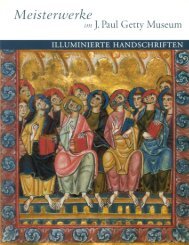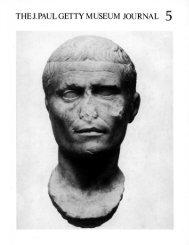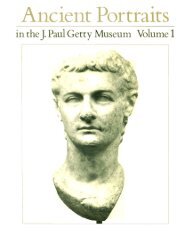<strong>The</strong> God Apollo 33Figures 4a-b. Left, Didrachm (obverse). Struck at Locri by King Pyrrhus of Epirus,before 280 B.C. Silver. Diam: 23.5 mm ( 1 5 /i6"). Right, reverse. Boston,<strong>Museum</strong> of Fine Arts, <strong>The</strong>odora Wilbour Fund in Memory of ZoeWilbour, 1985.235. Photos: Courtesy <strong>Museum</strong> of Fine Arts, Boston.Figure 5. Roundel with bust of Apollo.Early Hellenistic period.Gilded silver. Diam: 7 cm(2 3 A"). Boston, <strong>Museum</strong> ofFine Arts, <strong>The</strong>odora WilbourFund in Memory of ZoeWilbour, 1985.333. Photo:Courtesy <strong>Museum</strong> of FineArts, Boston.a fact made clear by the presence of the beast beside thegod in the <strong>Getty</strong>'s marble statue.Zeus, Demeter, and Kore, rather than Apollo, werethe major divinities of Locri. 16Apollo was present in asecondary way at Rhegium, around the toe of the Italian"boot" from Locri Epizephyrii, but at Caulonia justto the northeast, across the Sagras River, he was themajor patron divinity. Caulonia, however, was destroyedby Dionysius I of Syracuse about 388 B.C., andits territory was presented to the Locrians. 17Rhegiumwas treated in similar fashion in 387, but this city wasrestored by Dionysius II before 350 B.C. It was at thistime (350—300 B.C.) that Rhegium's bronze coinage featureda youthful Apollo with long hair similar to theimage on a silver-gilt plaque of the fourth century B.C.(fig. 5).«Thus, in a shrine to Apollo early in the third centuryB.C., it would seem suitable that a statue of the god be"Archaistic" to recall Caulonias famous image on silverstaters of 550 to 480 B.C., albeit in an updated sculpturalform. Apollo Katharsios had cured the Sagras coast ofplagues. Could this ensemble, the statue, the table, andthe basin have been the dedication of a prominent EpiroteMacedonian, like King Pyrrhus, intended to keepthe armies in Megale Hellas free of illness as well asfrom the surging power of Rome? Such is a possibleexplanation for three such unusual masterpieces ofGreek sculpture and painting in a single context.Given the theme of <strong>The</strong>tis with the shield of Achilleson the inside of the marble basin (fig. 3b) and on thereverse of the didrachm of Pyrrhus (fig. 4b), thereshould have been arms and armor found with this dedication.Such armor ought to have been of the highestartistic level and finest quality produced in the Greekworld in the age of Alexander the Great or the twogenerations of his successors and relatives. Figural denereidswith the arms of Achilles is given by Stella G. Miller, "Erosand the Arms of Achilles," AJA 90 (1986), p. <strong>15</strong>9, n. 2.14. See Lidia Forti and Attilio Stazio, "Vita quotidiana dei Grecid'ltalia," in Megale Hellas: Storia e civiltä della Magna Grecia (Milan,1983), p. 699, fig. 720, an example of a griffin and a stag, a heavilygilded relief in just the schema of this table support. H. Hoffmann,Ten Centuries That Shaped the West: Greek and Roman Art in TexasCollections (Houston, 1970), no. 135, p. 280, on the general meaning ofthese plaques. H. Herdejürgen, Die tarentinischen Terrakotten des 6. bis4. Jahrhunderts v. Chr. im Antikenmuseum Basel, Veröffentlichungen desAntikenmuseums Basel, Band 2 (Basel, 1971), nos. 71, 72, pp. 68—69,pl. 21, a stag facing a griffin as pendant plaques.<strong>15</strong>. This specimen is from the J. Vinchon sale, Monte Carlo, April13, 1985, lot 269. E. S. G. Robinson, Lloyd Collection, vol. 2 of SyllogeNummorum Graecorum (London, 1933), no. 657, pl. XXI.16. See E. Langlotz and M. Hirmer (supra, note 11), p. 271, pis.71—75, terracotta reliefs from Locri, dating about 450 B.C. <strong>The</strong>se reliefsfeature stylistic details of up to half a century earlier, perhapssetting the taste that produced the "Archaistic" marble Apollo of thelate fourth century B.C.17. B. V. Head, Historia Numorum (Oxford, 1911), pp. 92-94. AttilioStazio, "Moneta e scambi," in Megale Hellas: Storia e civiltä dellaMagna Grecia (Milan, 1983), pp. 122-123, 136, figs. 94-99.18. See Sale 6, Bank Leu A. G, Zurich, May 8, 1973, lots 43, 44.
34 Vermeuletails certainly would have been included, and the subjects,again, ought to have been linked with the mythsof Achilles, the greatest Greek hero and an ancestor ofAlexander and Pyrrhus.<strong>The</strong>re is a scrap of evidence that meets all these criteria,including the possibilities of provenance. <strong>The</strong> leftshoulder-plate of a bronze cuirass features a female headin an Amazonian cap, the side flaps of which turn intodecorative volutes at the curving edges of the background(fig. 6). She wears earrings of Lydian or Ionianform and a slender torque with a flower suspended fromit. This sad-faced Amazon can only be Queen Penthesilea,and her slight inward turn of the head affirms thededuction that another head rose out of the oppositeshoulder-plate. 19<strong>The</strong> head on the wearer's right, theplace of honor, could only have been Achilles. <strong>The</strong>body of the cuirass was probably undecorated, beyondsuggesting the ideal anatomy common to such objectsat the time, but the complete ensemble would have beenfully worthy of a princely dedication in the Italic aftermathof Alexander the Great. 20<strong>Museum</strong> of Fine ArtsBostonFigure 6. Queen Penthesilea on the left shoulder-plateof a cuirass. Early Hellenistic period. Bronze.H: 16 cm (6 5 /i6"). Boston, <strong>Museum</strong> of FineArts, Frank B. Bemis Fund, 1986.242. Photo:Courtesy <strong>Museum</strong> of Fine Arts, Boston.19. H (max.): 16 cm (6 5 /i6"); W (max.): 12 cm (4 n /ie"). <strong>The</strong> patinais the rich, deep green of the finest Greek metalwork from 350 to275 B.C.20. <strong>The</strong> comparable right shoulder-plates (covering the straps) ofGreek bronze cuirasses of the fourth century B.C. are collected on pp.51—54 of Arnold Hagemann, Der Metallharnisch, vol. 1 of GriechischePanzerung: Ein entwicklungsgeschichte Studie zur antiken Bewaffnung(Leipzig and Berlin, 1919). <strong>The</strong> famous Siris Bronzes in the British<strong>Museum</strong> (pp. 51—52, fig. 62) are basically the left and right shoulderplatesand back of the neck and shoulders of such a piece of armor.Also, H. B. Walters, Catalogue of the Greek, Roman, and EtruscanBronzes in the Department of Greek and Roman Antiquities (London,1899), no. 285, pp. 39-40, pi. VIII. In reasonably high relief, mirroredpairs of Greeks attack fallen Amazons, similarly balanced. <strong>The</strong>y arepossibly Achilles slaying Penthesilea on the left, and Ajax Oileusdispatching Derinoe on the right. <strong>The</strong> southeast coast of Italy as wellas western Mainland Greece, the Peloponnesus, and, lately, Macedoniaor Thrace are the sources for a number of these plates or coveringsfor cuirass fastenings.








